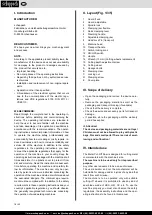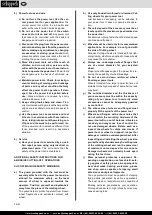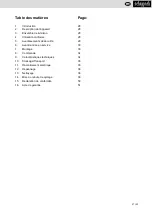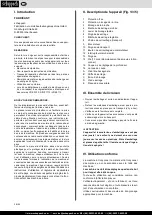
www.scheppach.com
+(49)-08223-4002-99
+(49)-08223-4002-58
19 І 52
c)
Do not expose power tools to rain or wet
conditions.
Water entering a power tool will
increase the risk of electric shock.
d)
Do not abuse the cord. Never use the cord
for carrying, pulling or unplugging the
power tool. Keep cord away from heat, oil,
sharp edges or moving parts.
Damaged or
entangled cords increase the risk of electric
shock.
e)
When operating a power tool outdoors,
use an extension cord suitable for outdoor
use.
Use of a cord suitable for outdoor use
reduces the risk of electric shock.
f)
If operating a power tool in a damp loca-
tion is unavoidable, use a residual current
device (RCD) protected supply.
Use of an
RCD reduces the risk of electric shock.
3) Personal safety
a)
Stay alert, watch what you are doing and
use common sense when operating a pow-
er tool. Do not use a power tool while you
are tired or under the influence of drugs,
alcohol or medication.
A moment of inatten-
tion while operating power tools may result in
serious personal injury.
b)
Use personal protective equipment. Al-
ways wear eye protection.
Protective equip-
ment such as dust mask, non-skid safety
shoes, hard hat, or hearing protection used for
appropriate conditions will reduce personal
injuries.
c)
Prevent unintentional starting. Ensure
the switch is in the off-position before
connecting to power source and/or bat-
tery pack, picking up or carrying the tool.
Carrying power tools with your finger on the
switch or energising power tools that have the
switch on invites accidents.
d)
Remove any adjusting key or wrench be-
fore turning the power tool on.
A wrench
or a key left attached to a rotating part of the
power tool may result in personal injury.
e)
Do not overreach. Keep proper footing and
balance at all times.
This enables better con-
trol of the power tool in unexpected situations.
f)
Dress properly. Do not wear loose cloth-
ing or jewellery. Keep your hair, clothing
and gloves away from moving parts.
Loose
clothes, jewellery or long hair can be caught in
moving parts.
g)
If devices are provided for the connection
of dust extraction and collection facilities,
ensure these are connected and properly
used.
Use of dust collection can reduce dust-
related hazards.
All persons who use and service the machine have to
be acquainted with this manual and must be informed
about the machineʼs potential hazards.
It is also imperative to observe the accident preven-
tion regulations in force in your area.
The same applies for the general rules of occupation-
al health and safety.
The manufacturer shall not be liable for any changes
made to the machine nor for any damage resulting
from such changes.
Even when the machine is used as prescribed it is still
impossible to eliminate certain residual risk factors.
The following hazards may arise in connection with
the machineʼs construction and design:
• Contact with the cutting-off wheel in the uncovered
cutting zone.
• Reaching into the cutting-off wheel while it is run-
ning (injuries through cutting).
• Kick-back of workpieces and parts of workpieces.
• Broken cutting-off wheels.
• Catapulting of damaged or cutting-off wheels.
• Damage to hearing if ear-muffs are not used as
necessary.
V. General Power Tool Safety
Warnings
m
WARNING! Read all safety warnings and all
instructions.
Failure to follow the warnings and in-
structions may result in electric shock, fire and/or se
-
rious injury.
Save all warnings and instructions for future ref-
erence.
The term “power tool” in the warnings refers to your
mains-operated (corded) power tool or battery-oper-
ated (cordless) power tool.
1) Work area safety
a) Keep work area clean and well lit. Cluttered or
dark areas invite accidents.
b) Do not operate power tools in explosive at-
mospheres, such as in the presence of flam
-
mable liquids, gases or dust. Power tools cre-
ate sparks which may ignite the dust or fumes.
c) Keep children and bystanders away while op-
erating a power tool. Distractions can cause
you to lose control.
2) Electrical safety
a)
Power tool plugs must match the outlet.
Never modify the plug in any way. Do not use
any adapter plugs with earthed (grounded)
power tools.
Unmodified plugs and matching
outlets will reduce risk of electric shock.
b)
Avoid body contact with earthed or grounded
surfaces, such as pipes, radiators, ranges and
refrigerators.
There is an increased risk of electric
shock if your body is earthed or grounded.
GB
















































